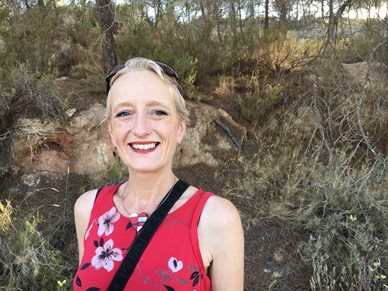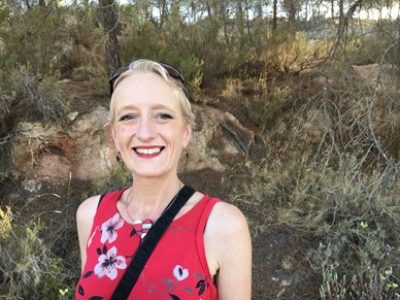



Ruth
It came as a complete shock to me and my family when I was diagnosed with Stage 3 locally advanced inoperable pancreatic adenocarcinoma at the start of November 2015.
I am a 42 year old married mum of two. My son is 21 and my daughter is 19. I have always enjoyed life and my hobbies include distance running, cycling, swimming, eating out and spending time with my amazingly supportive family and friends.
It came as a complete shock to me and my family when I was diagnosed with Stage 3 locally advanced inoperable pancreatic adenocarcinoma at the start of November 2015.
I had been fatigued for a couple of months, which I put down to work and a busy life, but in mid-October I noticed that I felt full quickly and slightly nauseous. I thought I had a bug, but when my urine turned a dark yellow a few days later and wouldn’t clear despite drinking plenty of fluids I knew something wasn’t right. I went to see my GP thinking I had a urine infection, but the results were negative. My GP asked me if my stools were OK, which they were, but the next day they turned pale and oily. I googled the symptoms and despite not suffering any abdominal pain feared the worst case scenario of pancreatic cancer.
My GP requested blood tests which showed abnormal liver function and very high bilirubin. When I saw my GP the next day he looked concerned and referred me for an ultrasound which he stated would take a couple of weeks. By this stage I was very concerned and didn’t want to wait a fortnight. During that evening I became increasingly jaundiced and went to the A&E department of the local general hospital where I was admitted.
It seemed like an age waiting for the relevant tests, including an ultrasound and CT scan, and even longer to get the results. I was told by the Consultant that the scans had shown a mass on the head of my pancreas which due to its location was likely to be cancerous, although there was a possibility it was benign. I was booked into a specialist hospital the following week for an ERCP procedure where a biopsy would be taken and a stent inserted to alleviate the jaundice.
The following week arrived and I was very anxious about having the ERCP procedure. Just before the procedure (which wasn’t as bad as I had feared) I was seen by the specialist consultant. He was hopeful the tumour was operable. For the first time I felt some hope.
There was a further wait of a week for the biopsy results. The stent had successfully alleviated the jaundice and that felt such a relief. I returned to the general hospital with my husband to receive the results of my biopsy from the consultant gastroenterologist.
He told us they had probably been too hopeful and positive and that it was time to get realistic. He said the tumour was inoperable due to contact with my SMA artery (superior mesenteric artery) and it would never become operable, that I might need a repeat biopsy as they couldn’t determine the type of cancer and that chemotherapy may not work. His words felt brutal and we left the room numb and devastated. To receive this news when I’d felt perfectly fit and was out running 8 miles only a few weeks before was unbelievable.
I spoke to a specialist nurse a few days later who told me I wouldn’t need a repeat biopsy as they had been able to determine the tumour type and reassured me that I would be offered some form of treatment.
A few days before my first appointment with an Oncologist (six weeks after first showing symptoms) I had a second opinion from a surgeon who told me chemotherapy could shrink the tumour away from the artery making it operable. There was a small section of portal vein involved which he said could be reconstructed. However the positivity was short lived when a few days later my oncologist told us the chances of the chemo shrinking the tumour was not zero but highly unlikely. He told me the biopsy had confirmed adenocarcinoma on the head of the pancreas and the only thing which could be offered was chemotherapy to prolong my life. The Oncologist asked me if I wanted a prognosis which I declined. My own research had seen the standard 6-12 month prognosis and I’d told myself I wasn’t going to be influenced by stats.
My mid treatment scan in March showed no discernible growth of the tumour or spread of the disease, which was seen as a positive result, but I was shocked to hear they assessed the tumour to have always been around 2cm by 4cm, twice the size I was originally told. Crucially, it had not moved away from the SMA so was still deemed inoperable. The NHS plan was to continue with a further 6 cycles of chemo, rescan then possibly have chemoradiotherapy. I was told that the chances of it ever becoming operable were very low. I knew it would only be a matter of time before it spread.
I started to feel out of control and felt I needed to be more proactive in my treatment. It’s very difficult to be proactive and research when dealing with this disease. I was still processing the diagnosis and managing my emotions as well as doing practical things like shopping, cleaning, looking after family, dealing with life insurance, work and juggling appointments.
People want to offer support and hear what’s happening but it’s exhausting going through the story and of course people don’t realise just how many times you’ve already had to talk about it. I learned how to divert the conversation and avoid it. It’s difficult because with this type of cancer there aren’t many positive stories so people tend to look in sympathy and horror but can’t offer any reassurance. My GP had told me at the start to not allow the cancer to define me. She was correct but it’s almost impossible to escape it and it can become all consuming.
I started to do my own research as I knew the NHS had its limitations. I had read about the nanoknife in London and also a specialist hospital in Heidelberg, Germany, with a Professor there who is very well known for performing pancreatic surgery when deemed inoperable in other countries. My oncologist referred me to both hospitals (sending my notes and scans) on the understanding I would need to finance the treatments myself.
I first had a consultation in London regarding nanoknife and I was deemed suitable. I felt very positive about this as the doctor told me a paper with positive outcomes was about to be published and the fact the treatment was quick and not invasive, with a short recovery time made it seem a good option. However in the meantime we heard from the hospital in Germany who, having seen my scans, advised me to travel there for a consultation.
Three days after the nanoknife appointment I met with the German Professor who felt there was a good chance he could remove the tumour, despite its proximity to the artery. If during the operation he found that he couldn’t remove the tumour, he would close me up again. The thought of a potentially long and painful recovery when I might not have ‘long left’ was a serious consideration, but I felt I simply had to go for the attempted surgery.
The ca-19 markers which are an indicator to tumour activity were now close to normal levels thanks to the chemotherapy. As the Professor said “Ruth, this is your chance.”
Two weeks later I was admitted to Heidelberg University hospital and taken to surgery. I had received nine of twelve Folfirinox chemo treatments and my 9th treatment had been two weeks prior to surgery. I was taken to the operating theatre at 9am and eight and a half hours later brought around in the recovery room to find out the “Whipple” operation had been successfully performed. An egg sized tumour had been cut away.
My current position is that I will need a further 3 chemotherapy sessions (Folfirinox) in order to complete the course of 12 originally planned. This is intended to start in August. I am having a CT scan at the end of July which will be 2 months post op. I feel apprehensive about this.
If this scan is clear I will have 3 monthly scans for the first year. I am having six weekly blood tests to check for diabetes as I am classed as being pre diabetic. I take Creon (enzyme replacement) with my meals, Immodium and codeine to help manage my stoma and a few vitamins. I have noticed that since the operation the neuropathy in the ends of my fingers appears to be worse.
Right through my treatment I have tried to keep fit and active on days that I have felt good and have had a number of short breaks away including trips abroad. Part bucket list, part not wanting the cancer to rule my life. Last week I went with the family to London for three days and walked ten miles on the Sunday, something which I never imagined being able to do so soon after surgery. I paid for it the following two days though, as I was utterly exhausted. This really taught me a lesson and I’ve been pacing myself since. My body often tells me when I need to rest and usually I have a couple of hours sleep or at least a lie down in the afternoon.
Although I am in a much better situation than I was a couple of months ago I know this cancer has a tendency to return, but like others I am going to have to learn to live with uncertainty. I have been very lucky that the chemotherapy has worked on me and that, in the end, the tumour was operable. Reading other people’s positive stories helped me and I hope sharing my experiences will have a similar effect on others. Don’t be dragged down by the statistics, anecdotally at least they are improving and most importantly, remember we are all individuals.
July 2016
Ruth’s experience of recovering from a Whipple’s procedure
I was diagnosed with Stage 3 locally advanced inoperable pancreatic adenocarcinoma at the start of November 2015. I had chemotherapy and travelled to Heidelberg in Germany for a Whipple’s operation. The Professor there is very well known for performing pancreatic surgery when deemed inoperable in other countries.
The Whipple’s operation was successfully performed. The head of my pancreas, duodenum, bile duct, gall bladder and part of my small intestine had all been removed and my portal vein resected. But most importantly the egg sized tumour had been cut away.
I could not believe how sore and unable to move I was when I came around from surgery. I only spent a few hours in the recovery room before being transferred to the ward. I just could not move and had tubes coming out of many areas. I was on strong pain relief. I expected to be fed through a tube, but this wasn’t the case. I was quickly able to drink and the next day I had a yoghurt. The nurses wanted me to stand up and walk a few steps the day after surgery. I thought there was absolutely no way I’d be able to do it but with their assistance I managed a few steps.
Each day the nurses got me up to walk a little further with the aid of a frame. I honestly thought it would take me weeks to walk properly again as this was very difficult and exhausting.
After a few days I was transferred to a general private ward where there were two patients per room. I was incredibly lucky to be placed with another young woman from the UK. Being able to communicate and share experiences made the stay in hospital all the more bearable.
The drains and tubes were taken out of me one by one and after only 4-5 days to my surprise I was taken off all pain killers. It was at this point I discovered I had a reversible ileostomy. An ileostomy is where the small bowel (small intestine) is diverted through an opening in the tummy. The opening is known as a stoma. A bag is placed over the stoma to collect waste products that usually pass through the colon (large intestine). The ileostomy was a surprise following surgery. It was done because a possible leak from the bowel into an area of blood vessels that had been operated on would increase the chance of post-surgery infection, which in turn would lead to a more complicated and longer recovery. It can be reversed between 3-6 months but of course involves further surgery.
The ileostomy has been difficult to manage, but with the support and advice from the stoma nurses and dietician it is becoming more manageable.
Each day I became stronger and after around ten days I suddenly found myself walking more freely. I remained in hospital for two weeks post-surgery. My histology report following surgery was positive in that all the lymph nodes removed were all clear. I was discharged on the Monday and we flew home a few days later after an outpatients appointment on the Thursday. My husband stayed for the three weeks we were in Germany.
I am now six weeks post-surgery and my illeostomy is settling. I’m receiving support from the excellent stoma nurses and dietitian in the UK. The other side effect from an over active illeostomy and major surgery has been weight loss. I dipped under 8 stone and this is a 2 stone weight loss from initial diagnosis. I am trying to eat calorie rich foods little and often. Other than these issues I appear to be recovering well. My scar has healed well and I have no pain.
July 2016
Update February 2017
I thought now would be a good time to post and update since I posted my original story. I was hoping I would have had a reprieve following the Whipple operation at the end of May 2016. This was not to be as my two month post op follow up scan showed six lesions to my liver which my Consultant told me were highly likely to be liver metastasis as my CA-19 markers had also significantly risen. A contrast MRI liver scan confirmed they were indeed liver mets. This was devastating news for all of us after everything we had been through and especially so soon after major surgery when I was only just starting to recover and generally feeling weak.
My weight had also dropped by a stone following the Whipple. I believe the drop in weight was due to the operation but also the impact of having a stoma. Management of a stoma cannot be underestimated and I appear to have an over active stoma meaning I was losing a lot of fluid. My Consultant was concerned that I would not have the strength for further Folfirinox chemotherapy. I had to agree I felt weak and did not know whether I could tolerate more of this chemotherapy. A decision was made that I would commence a six month course of Gemcap.
In the meantime I had all of my recent scans sent to a Professor in London who specialises in liver ablations. He looked at my scans and told me I was suitable for liver ablation and this would be performed over two sessions ablating three tumours each time. This was done privately. I was booked in for October. I was amazed at the ease of this procedure. The ablation took around 45 minutes. I recovered during the evening, slept all night and awoke in the morning feeling fine. After being checked by the Professor I was discharged the following morning. I was told the procedure went well. I returned a couple of weeks later for the second procedure which blasted the last three tumours. I felt a little tender around the liver area for a few days but this soon subsided.
My CT and MRI scan in November showed the six tumours had significantly reduced in size and were now minimal. My tumour markers had also significantly reduced so the combination of chemotherapy and ablations had been successful in giving the disease a good knock back.
I am generally feeling well in myself although I get tired and my appetite isn’t what it used to be which isn’t surprising really. I would say my main current issue is low weight. I don’t know how much of this is due to having a stoma or the illness. Despite having a reduced appetite I ensure that I eat well so I think the stoma output has a lot of influence on my weight. I have developed an addiction to oranges and can’t get enough of them despite taking a slow release strong vitamin C capsule each day. I have to be careful as too many oranges won’t help my stoma output and I am on maximum dose of all medications used to control this. I plan to have a review with the stoma consultant to discuss whether a stoma reversal would be an option. However I am uncertain as to whether this is realistic and the thought of further surgery and recovery does not sound appealing. I will have to listen to what the specialist advises and weigh up the pro’s and cons.
I try and keep as active and busy as possible and am managing this. My diary always seems to be full. I have to say no though when I am doing too much and my body is good at telling me when I have to stop. I’ve not been able to cycle very much but this has been due to the cold weather. I was officially granted ill health retirement after nearly 25 years working in the NHS in December. I never expected this would happen so early in my career and thought I would be working for another 20 years. It was upsetting and sad to let go of my career which I had worked so hard to achieve but it was the right decision.
Both my husband and myself did a good amount of fundraising for Pancreatic Cancer UK in November and December last year. This involved a number of quizzes in November for Pancreatic Cancer awareness month and a one night gig in early December which was a fantastic success. We raised a really decent amount of money which was the objective.
I have a meeting with the Phase 1 Clinical trials team next week and this will be interesting to see if there are any up and coming trials which I maybe suitable for. We will have to wait and see. In the meantime I take one day at a time and enjoy as much time with my family and friends as possible.
Ruth’s experience of FOLFIRINOX and GemCap chemotherapy
Ruth was diagnosed with inoperable pancreatic cancer in November 2015. She had FOLFIRINOX chemotherapy, followed by surgery to remove the cancer, and then gemcitabine and capecitabine chemotherapy (GemCap).
A week after my official diagnosis and first appointment with my Oncologist I had a Hickman line inserted to deliver chemotherapy. This was straight forward and I experienced no pain. A week later I commenced Folfirinox chemotherapy every two weeks.
I had 6 cycles of chemotherapy and during this time my tumour markers were reducing which was positive news that the chemotherapy was working. On a few occasions treatment was postponed due to my neutrophils being too low and half of my treatments were given at three weekly intervals because of this. After each chemotherapy treatment I would generally sleep for 3 days and then my energy would pick up and I would be feeling good the second week. I have been lucky in that I haven’t suffered with bad sickness and only nausea. I was given medication to help with this.
[Following nine sessions of FOLFIRINOX, Ruth went to Germany for her surgery. Unfortunately, scans showed that she had tumours in her liver. She then started GemCap, as her consultant was worried she wasn’t strong enough for more FOLFIRINOX. She has had ablation treatment for the tumours in her liver.
I have now completed the six month course of Gemcap chemotherapy. I have a CT and MRI scan in a few weeks and regardless of the results I have a 12 week treatment break. I have to admit that I am ready for a break due to the accumulative effects of treatment but also because the hospital visits are so draining. It will be nice to not have to go to the hospital.
I have generally tolerated the GemCap regime well. I have suffered with mouth ulcers on a couple of occasions but both times these have been at the end of the treatment cycle and only lasted a few days. I used Difflam mouthwash which helped but they were very painful and made talking and eating difficult. I have also suffered with dry soles of my feet which have resulted in some nasty deep cracks. I have been prescribed Aveeno cream and this helps. The other main effect has been the fact that I get cold very easily. I am sure this is due to having little body fat, the weather being generally very cold and also treatment. I have invested in lots of thermals and always wrap up well when going out.
February 2017




